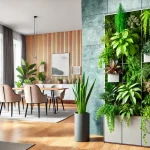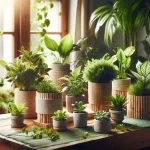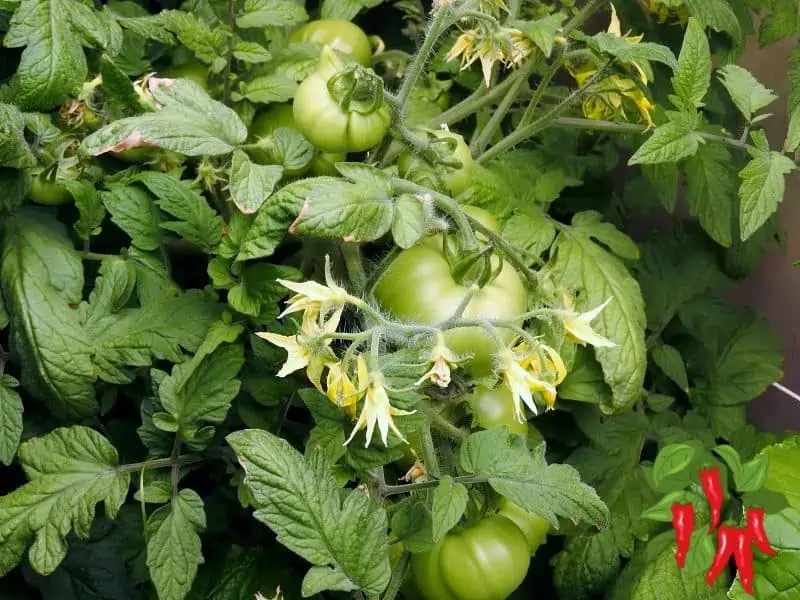This post may contain affiliate links. If you buy something from one of our links we may earn a commission. Thanks
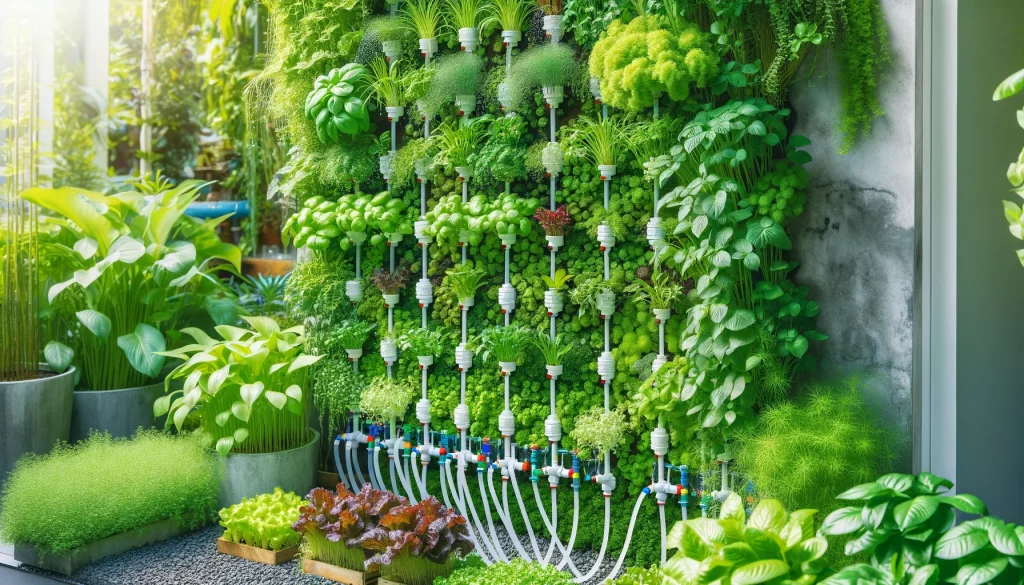
Are you struggling to keep your vertical garden lush and thriving? Discovering the perfect vertical garden irrigation method could be the game-changer you need!
Vertical Garden Irrigation involves using drip systems, self-watering setups, or manual methods to deliver water directly to the roots, ensuring efficient and consistent hydration for your plants.
Vertical Garden Irrigation: A Comprehensive Guide
Hey there, gardening enthusiasts! Ever feel like keeping your vertical garden hydrated is more challenging than you expected?
Improper watering can lead to all sorts of issues, like overwatering, underwatering, and stressed-out plants. But don’t worry!
Finding the right vertical garden irrigation system can turn things around and help your plants thrive. Stick around to learn the best tricks and tips to keep your green wall lush and healthy!
1. Understanding Vertical Garden Irrigation
Watering a vertical garden can seem tricky, but understanding the basics can make it a breeze.
Vertical garden irrigation involves delivering water efficiently to ensure your plants thrive without the hassle.
Let’s break down why it’s essential and how it benefits your green space.
Definition and Importance of Vertical garden irrigation
Vertical garden irrigation refers to the methods and systems used to water plants arranged vertically.
This setup is crucial because it ensures even water distribution, prevents water wastage, and supports the health and growth of plants by providing consistent moisture levels.
Benefits: Water Conservation, Precise Control, Reduced Manual Effort
- Water Conservation: Vertical garden irrigation systems, like drip irrigation, minimize water waste by delivering water directly to the plant roots, reducing evaporation and runoff.
- Precise Control: These systems allow gardeners to control the exact amount of water each plant receives, ensuring optimal hydration tailored to each plant’s needs.
- Reduced Manual Effort: Automated irrigation systems reduce the need for manual watering, saving time and effort while ensuring plants get watered consistently, even when you’re not around.
By understanding and implementing efficient irrigation methods, you can maintain a vibrant and healthy vertical garden with minimal hassle.
2. Types of Irrigation Systems
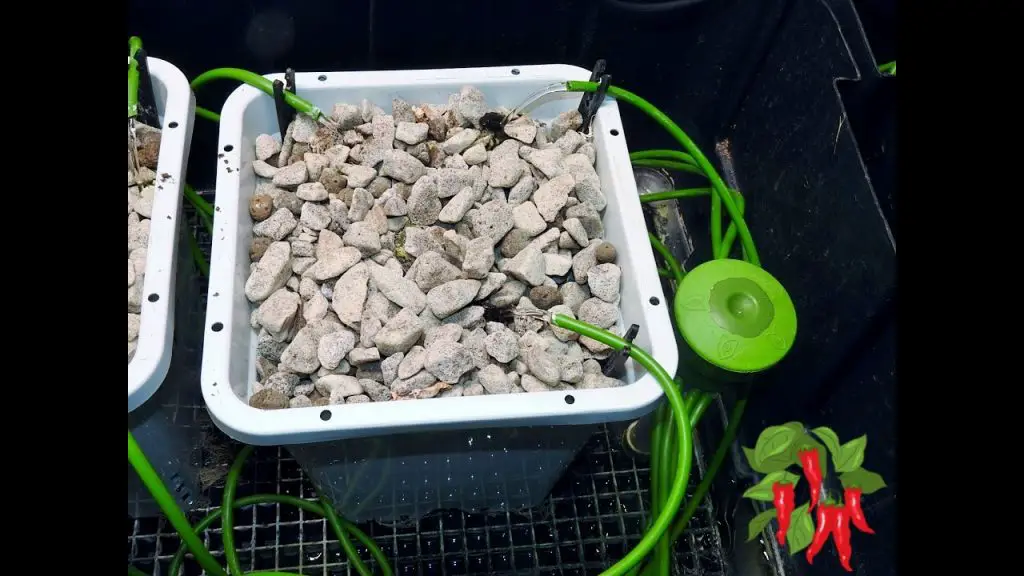
Choosing the right irrigation system for your vertical garden is key to keeping your plants healthy and happy.
There are various options available, each with its own perks. Let’s explore the different types of irrigation systems you can use to make watering your vertical garden a breeze.
Drip Irrigation Systems
Drip irrigation systems are fantastic for vertical gardens. They deliver water directly to the roots of each plant, which means less water waste and more precise watering.
This system uses a network of tubes and emitters to ensure every plant gets the right amount of moisture, making it perfect for maintaining a healthy vertical garden.
Self-Watering Systems
Self-watering systems are great if you want a low-maintenance option. These systems typically include built-in reservoirs that slowly release water to the plants as needed.
This setup can keep your plants hydrated for days, so you don’t have to worry about daily watering chores.
Manual Watering Options
If you prefer a hands-on approach, manual watering options are for you. Using tools like long-spout watering cans or spraying wands can give you control over how much water each plant gets.
It’s a bit more work but can be quite satisfying to see your plants thrive from your direct care.
Automated Timer Systems
Automated timer systems are perfect for those who want a set-it-and-forget-it solution.
These systems connect to your irrigation setup and schedule watering times, ensuring your plants get watered regularly without you having to lift a finger.
It’s a great way to make sure your plants stay healthy even when you’re away.
Reservoir-Based Systems for Indoor Gardens
For indoor vertical gardens, reservoir-based systems are ideal. These systems use a water reservoir and a series of tubes to deliver water to each plant.
They are particularly useful in indoor settings where you might not have access to an outdoor water source.
Plus, they help maintain consistent moisture levels, which is crucial for indoor plants.
By choosing the right irrigation system, you can simplify your gardening routine and ensure your vertical garden remains lush and vibrant all year round.
3. Key Components of Vertical Garden Irrigation Systems
Alrighty, folks, let’s break down the essential parts of a vertical garden irrigation system.
These components work together to ensure your garden gets just the right amount of water.
Knowing these parts will help you set up and maintain an efficient system.
Splitters and Pressure Reducers
First up, we have splitters and pressure reducers. Splitters are handy little tools that let you divert water from a single source to multiple outlets, making it easy to water different sections of your vertical garden.
Pressure reducers are crucial because they ensure the water pressure isn’t too high, which can damage your system and plants. These gadgets help maintain a steady flow that’s perfect for drip irrigation.
Filters and Emitters
Next, we have filters and emitters. Filters are essential for keeping your irrigation system free from debris and particles that could clog it up. Clean water means your system runs smoothly.
Emitters are the parts that actually release water to your plants. They come in various types, allowing you to control how much water each plant gets.
Whether you need a slow drip or a steady stream, emitters have got you covered.
Water Distribution Pipes
Water distribution pipes are the veins of your irrigation system. These pipes transport water from the source to the emitters, ensuring every plant gets its share.
They need to be durable and flexible to navigate through your vertical garden setup. Properly installed pipes mean efficient watering and a healthy garden.
Timers and Automation Tools
Last but not least, let’s talk about timers and automation tools. These are the brain of your irrigation system.
Timers allow you to schedule watering times, so your plants get watered consistently, even when you’re not around.
Automation tools can include sensors and smart controllers that adjust watering based on weather conditions or soil moisture levels.
It’s like having a personal assistant for your garden!
With these components in place, your vertical garden irrigation system will run like a well-oiled machine, keeping your plants happy and thriving. Keep it green, everyone!
4. Installing a Drip Irrigation System
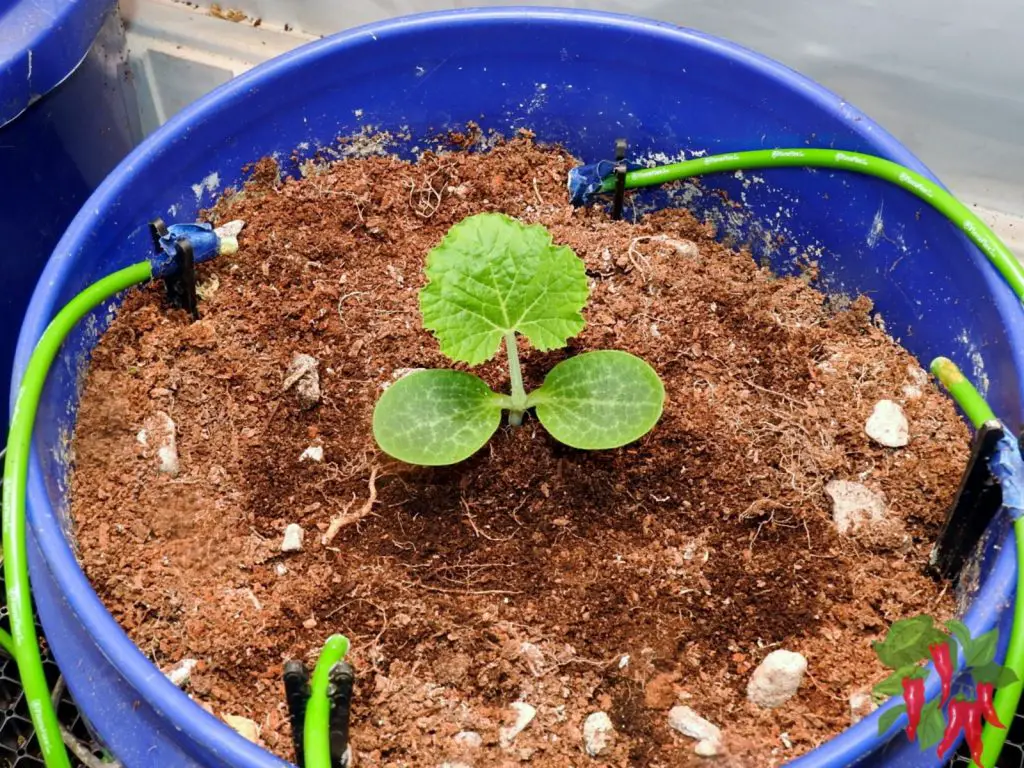
Let’s dive into installing a drip irrigation system for your vertical garden. This setup will save you time and ensure your plants get the water they need without any fuss. Here’s a step-by-step guide to get you started.
Planning Your Layout
First things first, plan your layout. Take a good look at your vertical garden and decide where you want to place the main water line and emitters.
Think about the placement of your plants and how the water will flow to each one. Sketching a simple diagram can help visualize everything before you start.
Choosing the Right Equipment
Next up, choosing the right equipment. You’ll need a main water line, emitters, a pressure regulator, a filter, and a timer if you want to automate the process.
Make sure your equipment is compatible with each other and suitable for your garden’s size.
High-quality components will ensure a reliable system and fewer headaches down the line.
Step-by-Step Installation Guide
- Connect the Main Line: Attach your main water line to your water source. If you’re using a hose spigot, you might need a splitter so you can still use your hose while running the irrigation system.
- Install the Pressure Regulator and Filter: These are crucial to prevent damage from high water pressure and keep debris out of your system. Connect them to your main line right after the water source.
- Lay Out the Main Line: Run the main water line along your vertical garden structure. Use clips or ties to secure it in place. Make sure it’s stable and won’t move around.
- Add Emitters: Poke small holes in the main line where each plant is located and insert the emitters. These will drip water directly to the base of your plants. Adjust the spacing according to your garden’s layout.
- Set Up the Timer: If you’re using a timer, connect it to your main line at the water source. Program it to water your plants at optimal times, usually early in the morning or late in the evening.
- Test the System: Turn on the water and check for leaks or clogs. Make sure each emitter is working properly and delivering water to the plants.
Adjusting for Height and Plant Types
Finally, adjust for height and plant types. Taller plants or those with higher water needs might require more frequent or longer watering times. You can add more emitters or use adjustable ones to control the water flow for different plants.
By following these steps, you’ll have a well-functioning drip irrigation system that keeps your vertical garden thriving with minimal effort. Happy gardening, and keep it green!
5. Maintenance and Troubleshooting
Keeping your vertical garden’s irrigation system in top shape is crucial for its long-term success.
Regular maintenance and troubleshooting can prevent most issues before they become serious problems. Here’s how to keep things running smoothly.
Regular Inspections and Cleaning
First off, regular inspections and cleaning are key. Check your irrigation system weekly for any signs of wear and tear.
Look for leaks, broken emitters, and any build-up of debris.
Cleaning filters and emitters periodically will help maintain water flow and prevent clogs. A quick rinse under running water usually does the trick for most components.
Adjusting Watering Schedules Based on Seasons
Your plants’ water needs can change with the seasons. During hot summer months, your garden may need more frequent watering.
In cooler months, you can cut back. Adjust your timer settings to match the current weather conditions and the specific needs of your plants.
Keeping an eye on the soil moisture can also guide you in making these adjustments.
Common Issues and Solutions: Kinks, Clogs, and Leaks
- Kinks in the Line: Kinks can restrict water flow. Straighten out any kinks you find and secure the lines to prevent them from recurring. Using flexible tubing can help minimize this issue.
- Clogs: Emitters can get clogged with dirt and debris. Regularly inspect and clean them. If you notice a drop in water pressure or uneven watering, clogs are often the culprit. Soaking emitters in a vinegar solution can help dissolve mineral build-up.
- Leaks: Leaks can waste water and reduce the efficiency of your system. Check all connections and lines for signs of leaks. Tighten any loose fittings and replace any damaged parts. Sometimes, a bit of plumber’s tape around the threads can fix minor leaks.
By staying on top of these maintenance tasks, you can ensure your vertical garden irrigation system remains efficient and effective, keeping your plants healthy and thriving. Happy gardening, and don’t forget to stay green!
6. Innovative Solutions: Blumats and DIY Options
Let’s get creative with some innovative irrigation solutions for your vertical garden. From high-tech Blumats to simple DIY kits, there are plenty of options to explore.
Here’s a look at some unique approaches that can make your vertical garden flourish.
Overview of Blumat Systems
Blumat Drip Irrigation System – Automatic Drip Irrigation Kits for Up to 12 Plants
Blumat systems are an excellent choice for those who want a more automated and responsive watering solution.
These systems use ceramic sensors that measure soil moisture and release water as needed. When the soil is dry, the sensors open to let water flow, and when the soil is moist, they close.
This self-regulating feature ensures your plants get the right amount of water at all times, which is especially handy if you’re often away from home.
DIY Drip Irrigation Kits
Rain Bird DRIPKITBAG Drip Irrigation Repair and Expansion Kit
If you enjoy a hands-on project, DIY drip irrigation kits are a fantastic option. These kits typically include all the components you need—tubing, emitters, connectors, and sometimes a timer.
You can customize the layout to fit your garden’s specific needs. Setting up a DIY system is a rewarding way to learn more about how irrigation works and can save you some money compared to pre-built systems.
Unique Irrigation Designs for Indoor Vertical Gardens
Indoor vertical gardens require some unique irrigation solutions to keep things neat and efficient. Here are a few ideas:
- Wicking Systems: Use capillary action to draw water up to the plants from a reservoir. This method is low-maintenance and ideal for smaller indoor setups.
- Hydroponic Towers: Combine vertical gardening with hydroponics for a soilless growing medium that circulates nutrient-rich water. These systems can be built at home with PVC pipes and a small water pump.
- Bottle Drip Systems: Recycle old plastic bottles by turning them into simple drip irrigation devices. Punch small holes in the caps, fill the bottles with water, and invert them into the soil. This provides a slow, steady supply of water to each plant.
These innovative solutions can help you maintain a lush, healthy vertical garden with minimal effort.
Whether you opt for a high-tech Blumat system, a custom DIY setup, or an inventive indoor design, there’s a perfect irrigation method for every gardener. Keep experimenting, and keep it green!
7. FAQs Vertical Garden Irrigation
Got some questions about vertical garden irrigation? You’re in the right place! Here are some frequently asked questions to help you out. Let’s get into it:
Q: How do vertical gardens get water?
A: Vertical gardens get water through various irrigation systems like drip irrigation, self-watering systems, and manual watering.
These systems deliver water directly to the plant roots, ensuring each plant gets the right amount of moisture.
Q: What is the best way to irrigate a vertical garden?
A: The best way to irrigate a vertical garden is by using a drip irrigation system. It provides precise control over water distribution, reduces water waste, and can be automated for convenience.
Self-watering systems and reservoir-based setups are also excellent options for consistent watering.
Q: Are there any drawbacks to using vertical gardens?
A: While vertical gardens are fantastic, they do have some drawbacks. They can be more challenging to water evenly, especially without a proper irrigation system.
Additionally, they may require more frequent maintenance and monitoring to prevent issues like root rot or nutrient deficiencies.
Q: How often should you water a vertical garden?
A: The frequency of watering depends on the type of plants, the climate, and the specific irrigation system you use.
Generally, vertical gardens need watering 2-3 times a week. However, during hotter months, you might need to water more frequently. Always check the soil moisture to guide your watering schedule.
Q: Is it better to water the garden in the morning or evening?
A: It’s best to water your garden in the morning. This gives plants time to absorb the water before the heat of the day, reducing the risk of evaporation and fungal growth.
If you can’t water in the morning, the early evening is a good alternative, but avoid late evening to prevent prolonged moisture on the leaves.
Q: Is it OK to water the garden every day?
A: Watering every day is usually unnecessary and can lead to overwatering, which can harm your plants.
However, drip irrigation systems will often water small amounts continually without overwatering.
Most plants prefer to have the soil dry out slightly between waterings. Adjust your watering schedule based on the soil moisture and plant needs to keep your vertical garden healthy.
There you have it! I hope these answers help you get the most out of your vertical garden. Keep experimenting and keep it green!
Vertical Garden Irrigation Conclusion
We’ve covered a lot about vertical garden irrigation, and now it’s time to bring it all together.
With the right knowledge and tools, you can keep your vertical garden thriving and lush. Here’s a quick recap and some final thoughts to inspire you on your gardening journey.
Recap of Key Points
- Understanding Vertical Garden Irrigation: Knowing the basics helps you provide consistent moisture and support plant health.
- Types of Irrigation Systems: From drip irrigation to self-watering and manual options, each system has its benefits.
- Key Components of Vertical Garden Irrigation Systems: Splitters, pressure reducers, filters, emitters, pipes, and timers are essential for an efficient setup.
- Installing a Drip Irrigation System: Plan your layout, choose the right equipment, and follow the step-by-step guide for a successful installation.
- Maintenance and Troubleshooting: Regular inspections, adjusting schedules, and solving common issues keep your system running smoothly.
- Innovative Solutions: Explore options like Blumat systems and DIY kits for unique and efficient irrigation solutions.
Read more: Indoor Vertical Gardening: Start Your Indoor Garden Now
Encouragement to Experiment and Customize Irrigation Systems
Every garden is unique, so don’t be afraid to experiment with different irrigation systems and customize them to fit your needs.
Whether you go high-tech with automation or keep it simple with manual watering, the goal is to find what works best for you and your plants.
Key Takeaways
- Regular maintenance and proper setup are crucial for effective vertical garden irrigation.
- Different irrigation systems offer various benefits; choose what suits your garden best.
- Customizing and experimenting with your irrigation setup can lead to better results.
- Morning watering is generally the best time to water your garden.
- Adjust watering frequency based on plant needs, soil moisture, and climate conditions.
Thanks for sticking with me through this guide. Happy gardening, and don’t forget to stay green!
Resources for Vertical Garden Irrigation
Here are some authoritative resources to help you further explore vertical garden irrigation. These websites provide in-depth information and research-based advice to support your gardening journey.
Here are some authoritative resources to help you further explore vertical garden irrigation. These .edu websites provide in-depth information and research-based advice to support your gardening journey.
- University of California Agriculture and Natural Resources (UC ANR)
- Drip Irrigation for Home Gardens
- This resource offers comprehensive guidance on setting up and maintaining drip irrigation systems, which are ideal for vertical gardens.
- Colorado State University Extension
- Gardening with Drip Irrigation
- Provides detailed information on the benefits, setup, and maintenance of drip irrigation systems, ensuring your vertical garden gets the moisture it needs.
- University of Florida IFAS Extension
- Efficient Irrigation
- Offers tips and strategies for efficient irrigation practices, which can be applied to vertical gardening to conserve water and promote plant health.
- University of Minnesota Extension
- Irrigation for Lawns and Gardens
- This guide covers various irrigation methods, including drip irrigation, and provides insights into watering schedules and system maintenance.
- Penn State Extension
- Watering Home Gardens and Landscape Plants
- Discusses different irrigation techniques and their applications, helping you choose the best system for your vertical garden.
These resources will provide you with reliable and research-backed information to optimize your vertical garden irrigation system. Happy gardening, and remember to stay green!
Visit my Amazon Influencer Page for videos and gardening products Grow Your Own Garden




